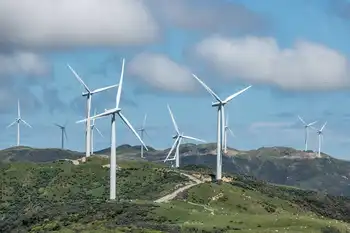sdfsdf
By sdfsdf
Substation Relay Protection Training
Our customized live online or in‑person group training can be delivered to your staff at your location.

- Live Online
- 12 hours Instructor-led
- Group Training Available
By sdfsdf
Our customized live online or in‑person group training can be delivered to your staff at your location.


Siemens Gamesa SG 14-222 DD advances offshore wind with a 14 MW direct-drive turbine, 108 m blades, a 222 m rotor, optional 15 MW boost, powering about 18,000 homes; prototype 2021, commercial launch 2024.
A 14 MW offshore wind turbine with 108 m blades and a 222 m rotor, upgradable to 15 MW, targeting commercial use in 2024.
✅ 14 MW direct-drive, upgradable to 15 MW
✅ 108 m blades, 222 m rotor diameter
✅ Powers about 18,000 European homes annually
Siemens Gamesa Renewable Energy (SGRE) has released details of a 14-megawatt (MW) offshore wind turbine, as offshore green hydrogen production gains attention, in the latest example of how technology in the sector is increasing in scale.
With 108-meter-long blades and a rotor diameter of 222 meters, the dimensions of the SG 14-222 DD turbine are significant.
In a statement Tuesday, SGRE said that one turbine would be able to power roughly 18,000 average European households annually, while its capacity can also be boosted to 15 MW if needed. A prototype of the turbine is set to be ready by 2021, and it’s expected to be commercially available in 2024, as forecasts suggest a $1 trillion business this decade.
As technology has developed over the last few years, the size of wind turbines has increased, and renewables are set to shatter records globally.
Last December, for example, Dutch utility Eneco started to purchase power produced by the prototype of GE Renewable Energy’s Haliade-X 12 MW wind turbine. That turbine has a capacity of 12 MW, a height of 260 meters and a blade length of 107 meters.
The announcement of Siemens Gamesa’s new turbine plans comes against the backdrop of the coronavirus pandemic, which is impacting renewable energy companies around the world, even as wind power sees growth despite Covid-19 in many markets.
Earlier this month, the European company said Covid-19 had a “direct negative impact” of 56 million euros ($61 million) on its profitability between January and March, amid factory closures in Spain and supply chain disruptions. This, it added, was equivalent to 2.5% of revenues during the quarter.
The pandemic has, in some parts of the world, altered the sources used to power society. At the end of April, for instance, it was announced that a new record had been set for coal-free electricity generation in Great Britain, where UK offshore wind growth has accelerated, with a combination of factors — including coronavirus-related lockdown measures — playing a role.
On Tuesday, the CEO of another major wind turbine manufacturer, Danish firm Vestas, sought to emphasize the importance of renewable energy in the years and months ahead, and the lessons the U.S. can learn from the U.K. on wind deployment.
“I think we have actually, throughout this crisis, also shown to all society that renewables can be trusted,” Henrik Andersen said during an interview on CNBC’s Street Signs.
“But we both know ... that that transformation of energy sources is not going to happen overnight, it’s not going to happen from a quarter to a quarter, it’s going to happen by consistently planning year in, year out.”

Thailand Covid-19 Electricity Bill Relief offers energy subsidies, tariff cuts, and free power for small meters, helping work-from-home users as authorities waive charges and discount kWh rates via EGAT, MEA, PEA for three months.
Program waiving or cutting household electricity bills for 22 million homes in March-May, easing work-from-home costs.
? Free power for meters <= 5 amps; up to 10M homes
? Up to 800 kWh: pay February rate; above, 50% discount
? >3,000 kWh: 30% discount; program valid March-May
The Thailand cabinet has formally approved energy authorities' decision to either waive or cut electricity charges, similar to B.C. electricity relief measures, for 22 million households where people are working at home because of the coronavirus disease.
Energy Minister Sontirat Sontijirawong said after the cabinet meeting on Tuesday that the ministers acknowledged the step taken by from the Energy Regulatory Commission, the Electricity Generating Authority of Thailand, the Metropolitan Electricity Authority and the Provincial Electricity Authority and noted parallels with Ontario's COVID-19 hydro plan rolled out to support ratepayers.
The measure would be valid for three months, from March to May, and cover 22 million households. It would cost the state 23.68 billion baht in lost revenue, he said, a pattern also seen with Ontario rate reductions affecting provincial revenues.
"The measure reduces the electricity charges burden on households. It is the cost of living of the people who are working from home to support the government's control of Covid-19," Mr Sontirat said.
The business sector also wants similar assistance, echoing sentiments from Ontario manufacturers during recent price reduction efforts. He said their requests were being considered.
Free electricity is extended to households with a power meter of no more than 5 amps. Up to 10 million households are expected to benefit, although issues like electricity payment challenges in India highlight different market contexts.
For households with a power meter over 5 amps, if their consumption does not exceed 800 units (kilowat hours), they will pay as much as they did in their February bill. The amount over 800 units will be subject to a 50 per cent discount, while elsewhere B.C. commercial consumption has fallen sharply.
Large houses that consume more than 3,000 units will get a 30 per cent discount, at a time when BC Hydro demand is down 10%.

New Zealand Energy Transition will electrify transport and industry with renewables, grid-scale solar, wind farms, geothermal, batteries, demand response, pumped hydro, and transmission upgrades to manage dry-year risk and winter peak loads.
A shift to renewables and smart demand to decarbonise transport and industry while ensuring reliable, affordable power.
✅ Electrifies transport and industrial heat with renewables
✅ Uses demand response, batteries, and pumped hydro for resilience
✅ Targets 99%+ renewable supply, managing dry-year and peak loads
As fossil fuels are phased out over the coming decades, the Climate Change Commission (CCC) suggests electricity will take up much of the slack, aligning with the vision of a sustainable electric planet powering our vehicle fleet and replacing coal and gas in industrial processes.
But can the electricity system really provide for this increased load where and when it is needed? The answer is “yes”, with some caveats.
Our research examines climate change impacts on the New Zealand energy system. It shows we’ll need to pay close attention to demand as well as supply. And we’ll have to factor in the impacts of climate change when we plan for growth in the energy sector.
Demand for electricity to grow
While electricity use has not increased in NZ in the past decade, many agencies project steeply rising demand in coming years. This is partly due to both increasing population and gross domestic product, but mostly due to the anticipated electrification of transport and industry, which could result in a doubling of demand by mid-century.
It’s hard to get a sense of the scale of the new generation required, but if wind was the sole technology employed to meet demand by 2050, between 10 and 60 new wind farms would be needed nationwide.
Of course, we won’t only build wind farms, as renewables are coming on strong and grid-scale solar, rooftop solar, new geothermal, some new small hydro plant and possibly tidal and wave power will all have a part to play.
Managing the demand
As well as providing more electricity supply, demand management and batteries will also be important. Our modelling shows peak demand (which usually occurs when everyone turns on their heaters and ovens at 6pm in winter) could be up to 40% higher by 2050 than it is now.
But meeting this daily period of high demand could see expensive plant sitting idle for much of the time (with the last 25% of generation capacity only used about 10% of the time).
This is particularly a problem in a renewable electricity system when the hydro lakes are dry, as hydro is one of the few renewable electricity sources that can be stored during the day (as water behind the dam) and used over the evening peak (by generating with that stored water).
Demand response will therefore be needed. For example, this might involve an industrial plant turning off when there is too much load on the electricity grid.
But by 2050, a significant number of households will also need smart appliances and meters that automatically use cheaper electricity at non-peak times. For example, washing machines and electric car chargers could run automatically at 2am, rather than 6pm when demand is high.
Our modelling shows a well set up demand response system could mitigate dry-year risk (when hydro lakes are low on water) in coming decades, where currently gas and coal generation is often used.
Instead of (or as well as) having demand response and battery systems to combat dry-year risk, a pumped storage system could be built. This is where water is pumped uphill when hydro lake inflows are plentiful, and used to generate electricity during dry periods.
The NZ Battery project is currently considering the potential for this in New Zealand, and debates such as whether we would use Site C's electricity offer relevant lessons.
Almost (but not quite) 100% renewable
Dry-year risk would be greatly reduced and there would be “greater greenhouse gas emissions savings” if the Interim Climate Change Committee’s (ICCC) 2019 recommendation to aim for 99% renewable electricity was adopted, rather than aiming for 100%.
A small amount of gas-peaking plant would therefore be retained. The ICCC said going from 99% to 100% renewable electricity by overbuilding would only avoid a very small amount of carbon emissions, at a very high cost.
Our modelling supports this view. The CCC’s draft advice on the issue also makes the point that, although 100% renewable electricity is the “desired end point”, timing is important to enable a smooth transition.
Despite these views, Energy Minister Megan Woods has said the government will be keeping the target of a 100% renewable electricity sector by 2030.
Impacts of climate change
In future, the electricity system will have to respond to changing climate patterns as well, becoming resilient to climate risks over time.
The National Institute of Water and Atmospheric Research predicts winds will increase in the South Island and decrease in the far north in coming decades.
Inflows to the biggest hydro lakes will get wetter (more rain in their headwaters), and their seasonality will change due to changes in the amount of snow in these catchments.
Our modelling shows the electricity system can adapt to those changing conditions. One good news story (unless you’re a skier) is that warmer temperatures will mean less snow storage at lower elevations, and therefore higher lake inflows in the big hydro catchments in winter, leading to a better match between times of high electricity demand and higher inflows.
The price is right
The modelling also shows the cost of generating electricity is not likely to increase, because the price of building new sources of renewable energy continues to fall globally.
Because the cost of building new renewables is now cheaper than non-renewables (such as coal-fired plants), investing in carbon-free electricity is increasingly compelling, and renewables are more likely to be built to meet new demand in the near term.
While New Zealand’s electricity system can enable the rapid decarbonisation of (at least) our transport and industrial heat sectors, international efforts like cleaning up Canada's electricity underline the need for certainty so the electricity industry can start building to meet demand everywhere.
Bipartisan cooperation at government level will be important to encourage significant investment in generation and transmission projects with long lead times and life expectancies, as analyses of climate policy and grid implications underscore in comparable markets.
Infrastructure and markets are needed to support demand response uptake, as well as certainty around the Tiwai exit in 2024 and whether pumped storage is likely to be built.
Our electricity system can support the rapid decarbonisation needed if New Zealand is to do its fair share globally to tackle climate change.
But sound planning, firm decisions and a supportive and relatively stable regulatory framework are all required before shovels can hit the ground.

Egypt-ENI Hydrogen MoU outlines joint feasibility studies for green and blue hydrogen using renewable energy, carbon capture, and CO2 storage, targeting domestic demand, exports, and net-zero goals within Egypt's energy transition.
A pact to study green and blue hydrogen in Egypt, leveraging renewables, CO2 storage, and export/demand pathways.
✅ Feasibility study for green and blue hydrogen projects
✅ Uses renewables, SMR, carbon capture, and CO2 storage
✅ Targets local demand, exports, and net-zero alignment
The Egyptian Electricity Holding Company (EEHC) and the Egyptian Natural Gas Holding Company (EGAS) signed a memorandum of understanding (MoU) with the Italian energy giant Eni to assess the technical and commercial feasibility of green and blue hydrogen production projects in Egypt, which many see as central to power companies' future strategies worldwide today.
Under the MoU, a study will be conducted to assess joint projects for the production of green hydrogen using electricity generated from renewable energy and supported by regional electricity interconnections where relevant, and blue hydrogen using the storage of CO2 in depleted natural gas fields, according to a statement by the Ministry of Petroleum on Thursday.
The study will also estimate the potential local market consumption of hydrogen and export opportunities, taking cues from Ontario's hydrogen economy proposal to align electricity rates for growth.
This agreement is part of Eni's objective to achieve zero net emissions by 2050 and Egypt's strategy towards diversifying the energy mix and developing hydrogen projects in collaboration with major international companies, taking note of Italy's green hydrogen initiatives in Sicily as a comparable effort.
It signed the deal with Egyptian Natural Gas Holding (EGAS) and Egyptian Electricity Holding Co. (EEHC).
The companies will carry out a joint study on producing renewable energy powered green hydrogen, informed by electrolyzer investments in similar projects, where applicable. They will also work on blue hydrogen. This involves reforming natural gas and capturing the resulting CO2, in this instance in depleted natural gas fields.
The study will also consider domestic hydrogen use and export options, including funding models like the Hydrogen Innovation Fund now in Ontario.
Eni said the MoU was in line with its plans to eliminate net emissions and emissions cancel emission intensity by 2050. The company noted the agreement was in line with Egypt’s plan for the energy transition, in which it pursues hydrogen plans with major international companies, alongside broader clean-tech collaboration such as Tesla cooperation discussions in Dubai, to accelerate progress.

Ontario NDP Hydro Plan proposes ending time-of-use pricing, buying back Hydro One, lowering electricity rates, curbing rural delivery fees, and restoring public ownership to ease household bills amid debates with PCs and Liberals over costs.
A plan to end time-of-use pricing, buy back Hydro One, and cut bills via public ownership and fair delivery fees.
✅ End time-of-use pricing; normal schedules without penalties
✅ Repurchase Hydro One; restore public ownership
✅ Cap rural delivery fees; address oversupply to cut rates
Ontario NDP leader Andrea Horwath says her party’s hydro plan will reduce families’ electricity bills, a theme also seen in Manitoba Hydro debates and the NDP is the only choice to get Hydro One back in public hands.
Howarth outlined the plan Saturday morning outside the home of a young family who say they struggle with their electricity bills — in particular over the extra laundry they now have after the birth of their twin boys.
An NDP government would end time-of-use pricing, which charges higher rates during peak times and lower rates after hours, “so that people aren’t punished for cooking dinner at dinner time,” Horwath said at a later campaign stop in Orillia, “so people can live normal lives and still afford their hydro bill.”
#google#
An NDP government would end time-of-use pricing, which gives lower rates for off-peak usage, Howarth said, separate from a recent subsidized hydro plan during COVID-19. The change would mean families wouldn't be "forced to wait until night when the pricing is lower to do laundry," and wouldn't have to rearrange their lives around chores.
The pricing scheme was supposed to lower prices and help smooth out demand for electricity, especially during peak times, but has failed, she said.
In order to lower hydro bills, Horwath said an NDP government would buy back shares of Hydro One sold off under the Wynne government, which she said has led to high prices and exorbitant executive pay among executives. The NDP plan would also make sure rural families do not pay more in delivery fees than city dwellers, and curb the oversupply of energy to bring prices down.
Critics have said the NDP plan is too costly and will take a long time to implement, and investors see too many unknowns about Hydro One.
"The NDP's plan to buy back Hydro One and continue moving forward with a carbon tax will cost taxpayers billions," said Melissa Lantsman, a spokesperson for PC Leader Doug Ford.
"Only Doug Ford has a plan to reduce hydro rates and put money back in people's pockets. We'll reduce your hydro bill by 12 per cent."
Ford has said he will fire Hydro One CEO Mayo Schmidt, and has dubbed him the $6-million-dollar man.
Horwath has said both Ford and Liberal Leader Kathleen Wynne will end up costing Ontarians more in electricity if one of them is elected come June 7. Their "hydro scheme is the wrong plan," she said.

Global Coal Power Decline 2019 signals a record fall in coal-fired electricity as China plateaus, India dips, and the EU and US accelerate renewables, curbing carbon emissions and advancing the global energy transition.
A record 2019 drop in global coal power as renewables rise and demand slows across China, India, the EU, and the US.
✅ 3% global fall in coal-fired electricity in 2019.
✅ China plateaus; India declines for first time in decades.
✅ EU and US shift to renewables and gas, cutting emissions.
The world’s use of coal-fired electricity is on track for its biggest annual fall on record this year after more than four decades of near-uninterrupted growth that has stoked the global climate crisis.
Data shows that coal-fired electricity is expected to fall by 3% in 2019, or more than the combined coal generation in Germany, Spain and the UK last year and could help stall the world’s rising carbon emissions this year.
The steepest global slump on record is likely to emerge in 2019 as India’s reliance on coal power falls for the first time in at least three decades this year, and China’s coal power demand plateaus, reflecting the broader global energy transition underway.
Both developing nations are using less coal-fired electricity due to slowing economic growth in Asia as well as the rise of cleaner energy alternatives. There is also expected to be unprecedented coal declines across the EU and the US as developed economies turn to clean forms of energy such as low-cost solar power to replace ageing coal plants.
In almost 40 years the world’s annual coal generation has fallen only twice before: in 2009, in the wake of the global financial crisis, and in 2015, following a slowdown in China’s coal plants amid rising levels of deadly air pollution.
The research was undertaken by the Centre for Research on Energy and Clean Air , the Institute for Energy Economics and Financial Analysis and the UK climate thinktank Sandbag.
The researchers found that China’s coal-fired power generation was flatlining, despite an increase in the number of coal plants being built, because they were running at record low rates. China builds the equivalent of one large new coal plant every two weeks, according to the report, but its coal plants run for only 48.6% of the time, compared with a global utilisation rate of 54% on average.
The findings come after a report from Global Energy Monitor found that the number of coal-fired power plants in the world is growing, because China is building new coal plants five times faster than the rest of the world is reducing their coal-fired power capacity.
The report found that in other countries coal-fired power capacity fell by 8GW in the 18 months to June but over the same period China increased its capacity by 42.9GW.
In a paper for the industry journal Carbon Brief, the researchers said: “A 3% reduction in power sector coal use could imply zero growth in global CO2 emissions, if emissions changes in other sectors mirror those during 2018.”
However, the authors of the report have warned that despite the record coal power slump the world’s use of coal remained far too high to meet the climate goals of the Paris agreement, and some countries are still seeing increases, such as Australia’s emissions rise amid increased pollution from electricity and transport.
The US – which is backing out of the Paris agreement – has made the deepest cuts to coal power of any developed country this year by shutting coal plants down in favour of gas power and renewable energy, with utilities such as Duke Energy facing investor pressure to disclose climate plans. By the end of August the US had reduced coal by almost 14% over the year compared with the same months in 2018.
The EU reported a record slump in coal-fired electricity use in the first half of the year of almost a fifth compared with the same months last year. This trend is expected to accelerate over the second half of the year to average a 23% fall over 2019 as a whole. The EU is using less coal power in favour of gas-fired electricity – which can have roughly half the carbon footprint of coal – and renewable energy, helped by policies such as the UK carbon tax that have slashed coal-fired generation.
We will not stay quiet on the escalating climate crisis and we recognise it as the defining issue of our lifetimes. The Guardian will give global heating, wildlife extinction and pollution the urgent attention they demand. Our independence means we can interrogate inaction by those in power. It means Guardian reporting will always be driven by scientific facts, never by commercial or political interests.
We believe that the problems we face on the climate crisis are systemic and that fundamental societal change is needed. We will keep reporting on the efforts of individuals and communities around the world who are fearlessly taking a stand for future generations and the preservation of human life on earth. We want their stories to inspire hope. We will also report back on our own progress as an organisation, as we take important steps to address our impact on the environment.
Stay informed with our FREE Newsletter — get the latest news, breakthrough technologies, and expert insights, delivered straight to your inbox.

Explore 50+ live, expert-led electrical training courses –
